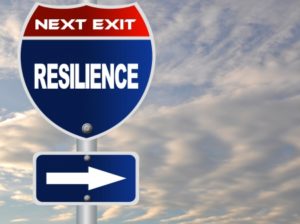By Rose O. Sherman, EdD, RN, FAAN
It is officially 2017. As we look at the new year in healthcare, there are many unknowns with a new administration. It is likely that some parts of the Affordable Care Act will change. Leaders in healthcare are not surprisingly worried about future reimbursement. These changes will come at an interesting time with so many other challenges including workforce shortages. Wise leaders know that the best strategy to deal with the inevitable ups and downs is to build their resiliency muscle.
What is Resiliency?
You have probably seen many examples in your life where people suffer an enormous setback but somehow bounce back. Psychologists call this resilience, or an ability to cope with problems and setbacks. Resilient people are able to utilize their skills and strengths to cope and recover from problems and challenges. This may include job loss, financial problems, illness, natural disasters, medical emergencies, divorce or the death of a loved one. Those who lack resilience might become overwhelmed by the same types of experiences.
Building Leadership Resiliency
Resiliency is important if you want a long and productive leadership career. You will never be able to eliminate all the stress or erase life’s difficulties. But having resilience will give you the strength to tackle problems head on, overcome adversity and move on with your life when difficulties occur. Resilient people view a difficulty as a challenge, not as a paralyzing event. They look at their failures and mistakes as lessons to be learned from, and as opportunities for growth. They don’t view them as a negative reflection on their abilities or self-worth. Here are 10 tips from the experts that can help you to become more resilient in your leadership or personal life during tough times:
1. Build positive beliefs in your abilities and focus on your signature strengths.
2. Find a sense of purpose in your work and life every day.
3. Develop a strong supportive network of family, friends and professional colleagues.
4. Embrace change as inevitable and recognize what is in your control and what is not.
5. Stay optimistic in the face of dark periods in your life – believe that things will get better and brighter days are ahead.
6. Nurture yourself with the right foods, exercise, recreation and sleep.
7. Develop your problem solving skills to overcome challenges.
8. Establish small and achievable goals.
9. Practice thought awareness so you don’t get into a cycle of negative thoughts.
10. Maintain perspective – don’t blow a setback out of proportion – instead learn from it.
Marty Seligman, a national expert on resilience, believes that the way that we explain setbacks to ourselves is the key to developing resilience. The reality is that we all fail from time to time, and everyone has crises in their lives. To develop resilience, you need to stop seeing yourself as a victim and be proactive in your own recovery. Ultimately, how we view adversity and stress strongly affects how we succeed. A resilient mindset is essential to successful leadership – in 2017 and beyond.
Read to Lead
Cherry, K. (undated article – About.com Psychology). 10 ways to become more resilient.
Mindtools Website Developing resiliency: Overcoming and growing from setbacks
Wicks, R. (2009). Bounce: Living the resilient life. Oxford University Press.
© emergingrnleader.com 2017



 LinkedIn
LinkedIn Instagram
Instagram